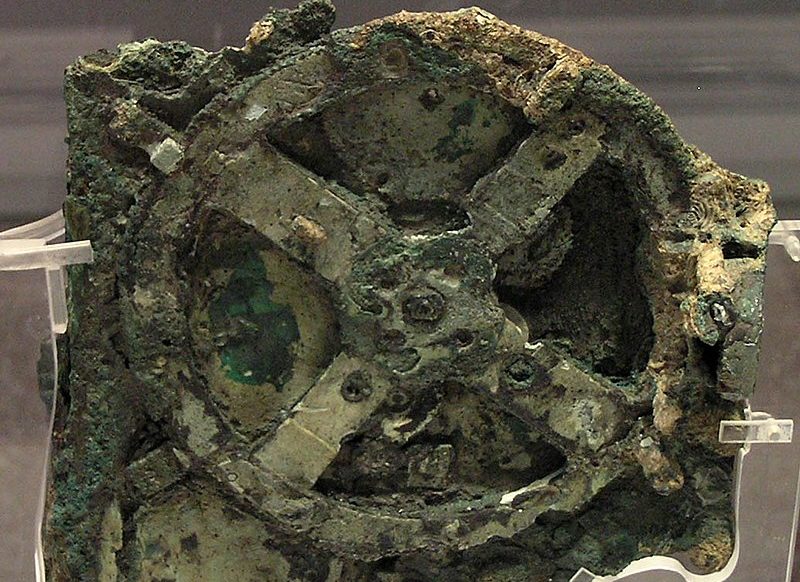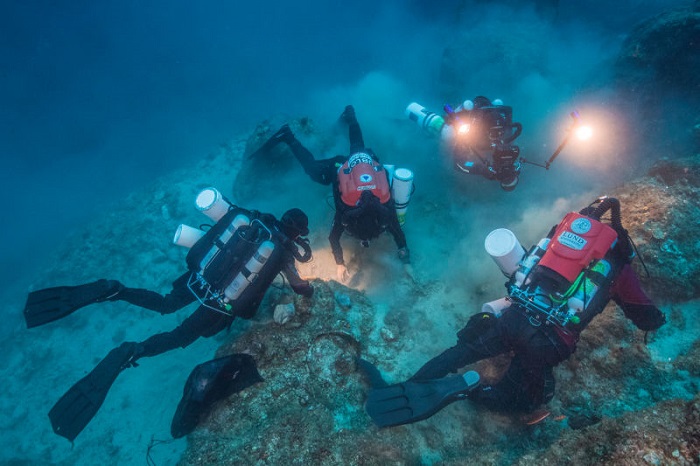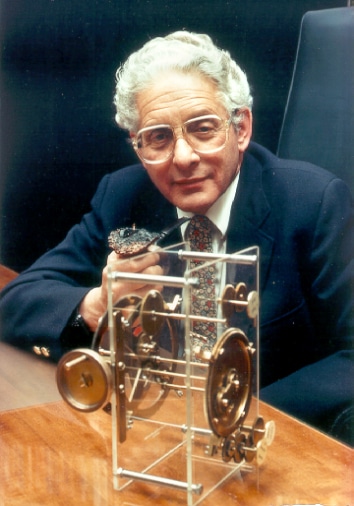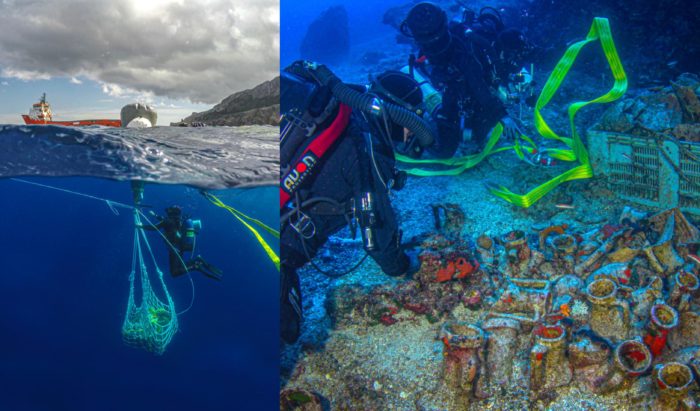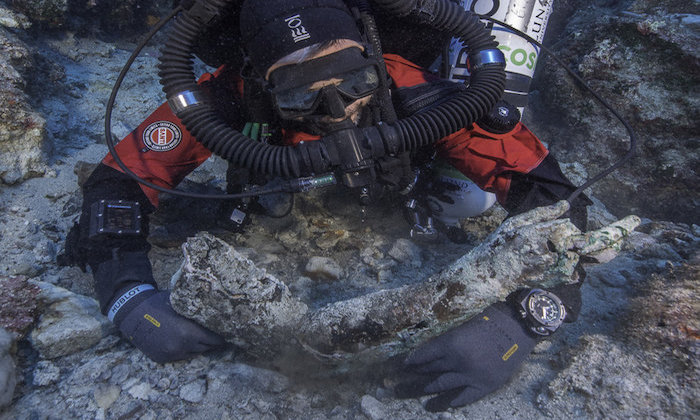DepthReading
The Antikythera Mechanism Secret Solved
The secret of the Antikythera Mechanism, the ancient Greek device discovered in 1901 and regarded as the world’s first computer, has been solved by scientists.
And now — exactly 120 years later — the astounding machine has been recreated once again, using 3-D imagery, by a brilliant group of researchers from University College London (UCL).
Not only is the recreation a thing of great beauty and amazing genius, but it has also made possible a new understanding of how it worked.
Since only 82 fragments of the original mechanism are extant – comprising only one-third of the entire calculator – this left researchers stymied as to its full capabilities.
Until this moment, the front of the Mechanism, containing most of the gears, has been a bit of a Holy Grail for marine archaeologists and astronomers.
Using computer modeling, the UCL researchers have reconstructed the ancient computer, allowing them to more fully grasp exactly what it was meant to do.
Professor Tony Freeth says in an article published in the periodical Scientific Reports: “Ours is the first model that conforms to all the physical evidence and matches the descriptions in the scientific inscriptions engraved on the Mechanism itself.
“The sun, moon and planets are displayed in an impressive tour de force of ancient Greek brilliance.”
The largest surviving piece of the Mechanism, referred to by researchers as “Fragment A,” has bearings, pillars and a block. Another piece, known as “Fragment D,” has a mysterious disk, along with an extraordinarily intricate 63-toothed gear and a plate.
The inscriptions — just discovered recently by researchers — on the back cover of the mechanism have a description of the cosmos, and the planets, shown by beads of various colors, move on rings set around the inscriptions.
By employing the information gleaned from recent x-rays of the computer, and their knowledge of ancient Greek mathematics, the UCL researchers have now shown that they can demonstrate how the mechanism determined the cycles of the planets Venus and Saturn.
Adding even more meaning to their discovery, the researchers have also been able to add all the missing information on the cycles of the other planets which had been missing up until now.
Much more than a mechanism: It’s mind-bogglingly complex astronomical computer
Evaggelos Vallianatos, author of many books on the Antikythera Mechanism writing at Greek Reporter said that it was much more than a mere mechanism. It was a sophisticated, mind-bogglingly complex astronomical computer. “And Greeks made it.”
They employed advanced astronomy, mathematics, metallurgy, and engineering to do so, constructing the astronomical device 2,200 years ago. These scientific facts, of the computer’s age and its flowless high-tech nature, profoundly disturbed some of the scientists who studied it.
A few Western scientists of the twentieth century were shocked by the Antikythera Mechanism, Vallianatos said. They called it an astrolabe for several decades and refused to call it a computer. The astrolabe, a Greek invention, is a useful instrument for calculating the position of the Sun and other prominent stars. Yet its technology is rudimentary compared to that of the Antikythera device.
The Antikythera computer was part and parcel of a wider plan of improving civilization itself. Greek philosophers added to the cosmic elements of cold, hot, dry, and wet, the concepts of equality and justice as governing virtues in the Cosmos, Vallianatos said.
That vision also made the Antikythera computer. Its front plate was a Cosmos of the Sun god Helios, his sister, Selene, the Moon, phases of the Moon, the planets and major stars and constellations. This Cosmos was embraced by the inside circle of the Zodiac with its 12 constellations and an outside circle of the 365-day year.
This genius computer was a pipeline between the gods and Greeks. It predicted the eclipses of the Sun and the Moon. It connected the Cosmos and natural phenomena to the Olympics and other Panhellenic celebrations of the gods and athletic and cultural competition and excellence.
Discovery of the Antikythera Mechanism
The Antikythera Mechanism was discovered inside an ancient shipwreck by Greek sponge divers on May 17, 1901. After numerous studies, it was estimated to have been constructed between 150 BC and 100 BC. A later study places it at 205 BC, just seven years after the death of Archimedes.
It was May 17, 1901 when Spirydon Stais, a Greek politician, visited a museum that housed treasures from an ancient shipwreck.
Among them was a round, green-encrusted piece of metal that caught his eye, as it looked like nothing else taken up from the bottom of the sea surrounding the tiny Greek island of Antikythera.
The shipwreck had just been accidentally discovered by local fishermen. One of them had emerged from the water clutching a bronze arm — the first find from the Antikythera wreckage.
Stais, instantly realizing this might signify a shipwreck of a great magnitude, organized the ancient wreck’s first underwater excavation. The findings were plentiful — and staggering in their import.
But the strange object which stood out from all the coins, pottery and sculptures found there was by far the most important of all.
It was what was later to be known as the “Antikythera Mechanism,” dubbed by scientists and archaeologists as the “world’s first computer.”
The ancient machine had been buried at the bottom of the sea for approximately 2,100 years. It consisted of bronze gears and other metallic mechanical parts, which had once moved smoothly but were rusty or encrusted with tarnish.
For decades, archaeologists and scientists attempted to discover what the complex mechanism was made for. They estimated that it had been constructed between 200 and 70 BC. In recent decades, researchers used X-rays and CT scans to look inside the Antikythera Mechanism and reconstruct it.
In a jaw-dropping realization, scientists discovered that the device was an elaborate construction of some thirty interlocking, spinning gears that controlled dials tracking the sun, the moon, eclipses, planets — and even the schedule for the Olympic Games.
A hand crank spun the gears which moved the hands on the dials. In this way, the user could predict eclipses and the passage of celestial bodies through the sky.
Antikythera Mechanism rewrote the history of science
In 2015, Kyriakos Efstathiou, a professor of mechanical engineering at the Aristotle University of Thessaloniki and head of the group which studied the Antikythera Mechanism said: “All of our research has shown that our ancestors used their deep knowledge of astronomy and technology to construct such mechanisms, and based only on this conclusion, the history of technology should be re-written because it sets its start many centuries back.”
The professor further explained that the Antikythera Mechanism is undoubtedly the first machine of antiquity which can be classified by the scientific term “computer,” because “it is a machine with an entry where we can import data, and this machine can bring and create results based on a scientific mathematical scale.
“Never before did we have such a device,” he declared.
“We do not simply refer to a computer but to a super-computer,” Efstathiou emphasized.
In 2016, yet another astounding discovery was made when an inscription on the device was revealed — something like a label or a user’s manual for the device.
It included a discussion of the colors of eclipses, details used at the time in the making of astrological predictions, including the ability to see exact times of eclipses of the moon and the sun, as well as the correct movements of celestial bodies.
Inscribed numbers 76, 19 and 223 show maker “was a Pythagorean”
On one side of the device lies a handle that begins the movement of the whole system. By turning the handle and rotating the gauges in the front and rear of the mechanism, the user could set a date that would reveal the astronomical phenomena that would occur around the Earth.
Physicist Yiannis Bitsakis has said that of course, today the NASA website can detail all the eclipses of the past and those that are to occur in the future. However, “what we do with computers today, was done with the Antikythera Mechanism about 2000 years ago,” he said.
A model of the Antikythera Mechanism was made by Derek De Solla Price. Credit: Public Domain
“what we do with computers today, was done with the Antikythera Mechanism about 2000 years ago,” he said.
By successfully reading 3,400 characters from the fragmented inscriptions, the research team has been able to recognize entire sentences, which has aided in understanding the functional object, forming something like a “manual” for the use of the instrument.
Astrophysics professor Xenophon Moussas has said that “today’s computers and mobile phones have their roots in the gears of the mechanism,” as evidenced by the inscriptions found on the object.
“This machine is the root of all civilization”
“The most important thing is that we see laws of physics applying inside the mechanism, and the proof is in the inscriptions and the numbers 76, 19, and 223 that also show the name of the manufacturer, which tell us clearly ‘I am a Pythagorean,’” Moussas said.
As the professor argued, this machine is the root of all civilization and technology and in fact, it is the oldest computer “tablet.”
The Mechanism also includes an astrological calendar, as the indicators seem to revolve around the zodiac, revealing the movements of both the Moon and the planets.
The machine was meant to be used in different locations
Making this incredible machine even more impressive is the fact that the movements of the planets are directly linked to specific observation sites around the known world at the time, suggesting that the creator of the Antikythera Mechanism had provided for the use of the machine in more than one location.
This incredible realization came about when scientists saw that the words “Dodona” and “Alexandria” were found in the machine’s engravings. The mechanism also included methods to estimate the time of sporting events held every four years, such as the Olympic Games and the Isthmian games, according to claims made by researchers.
All the scientists involved in the analysis of this incredible device — as well as many other researchers — agree that the Antikythera find is the most important maritime shipwreck discovery in human history.
Bones found at the Antikythera Mechanism shipwreck site
Greece’s Ministry of Culture issued a statement in late 2019 informing the public about the discoveries made at the wreck site which once yielded the Antikythera mechanism off the island of Antikythera, south of the Peloponnesian peninsula.
The statement noted that ”bones were collected, which now need to be analyzed, (as well as) olive kernels, and bronze nails from the ship as well as a bronze ring, whose use remains unknown.”
Among the findings which were discovered were sections of the bodies of ancient amphorae, as well as the bases and the necks from the main bodies of the vases.
The types of amphorae are identified as those which were typically used on the island of Kos and in Southern Italy in ancient times.
The Greek Ministry noted ”This scientific mission of October 2019 completed the first five-year research program. Based on the results of the latest research, preparations for the new five-year program, starting in May 2020, will begin immediately with the continuation of excavation research in various areas of the wreck, where there are good indications that impressive new findings will come to light.”
“The mission was concluded with great success despite adverse weather conditions and the limited length of time for the rescue research,” the Ministry added.
Video of excavations shows hazardous work of marine archaeologists
This research at the famed shipwreck site was made possible by support from the Athanasios Laskarides Public Benefit Foundation.
A video titled “2017 Return to Antikythera Expedition” looks at the delicate and often hazardous work marine archaeologists do in recovering ancient gems from the depth of the seas.
That expedition, led by the Greek Ephorate of Underwater Antiquities, Lund University, and Woods Hole Oceanographic Institution, was conducted between September 4 to 20 of that year, and as per previous trips to the wreck, the team did not leave disappointed.
With excellent weather conditions above them, the divers managed to recover an “orphaned” right arm of a bronze statue, pottery shards, nails, lead sheathing fragments, and an odd metal disc, among other artifacts.
Prior to that expedition, the Return to Antikythera project team managed to recover glassware, luxury ceramics, anchors, counterweights, tools, and even an ancient skeleton, which is still undergoing DNA analysis.
Category: English
DepthReading
Key words:


